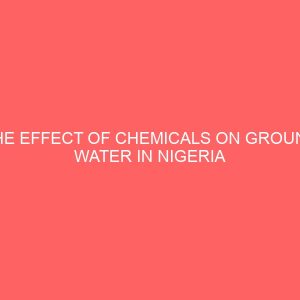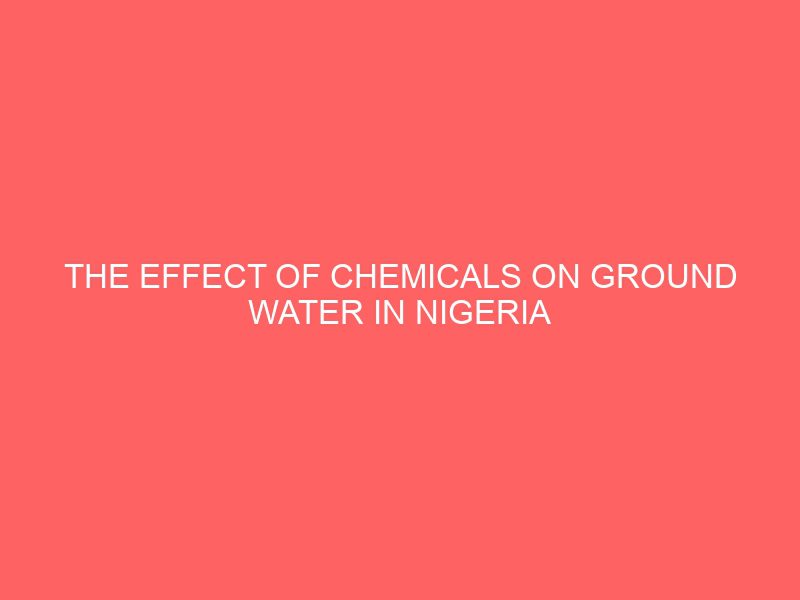Description
CHAPTER ONE INTRODUCTION 1.1 Background of the study Water is perhaps the most essential of all natural resources because it is fundamental to all vital processes of mankind. The quantitative supply of water can be a local issue, but in many regions the most serious problem hindering the utilization of water resources is the deterioration of water caused by chemicals, which leads to an estimated 25,000 deaths daily because of water ? related sicknesses (United Nations Population Information Network, Popin1994). Deficient water supplies and sanitation therefore pose the most serious environmental problems that face developing countries today. Ayoade and Oyebande (1973) noted that less than 30% of Nigerian cities are served by public water schemes. This fact remains true and is evident in Nigeria and its environs where private wells and boreholes ownership are common. In Nigeria and its environs, rapid urbanization and industrialization are ongoing, which implies an increase in the generation of domestic and industrial wastes, preponderance of individual septic tanks, indiscriminate drilling of boreholes with its attendant over?abstraction problems that enhance pollutant concentrations and saline water intrusion of the groundwater resources. Therefore, periodic examination to ascertain the quality of the groundwater is indispensable. The fact that most of the water consumed does not undergo treatment by the state public water utilities makes it pertinent to regularly conduct and monitor physical, chemical and biological analysis. Sources of water available to mankind are: atmospheric water (precipitate), surface water (including rivers, streams, ponds, etc), and ground water. The portability of water from any of these sources is determined by the water quality (Miller, 1997). With 97% of all freshwater found on the earth being stored underground, accessing ground water in the quest for potable water is a laudable venture. Groundwater is accessed by way of sinking wells and boreholes to reach the water table (Overseas Development Institute, 2009). Water-related diseases are responsible for 80% of all illnesses/death in developing countries (UNESC0, 2007). According to Kalua and Chipeta (2005) as cited in Pritchard, Mkandawire, and O?Neill (2008), in Malawi, only 65% of the population have access to safe drinking water and 50% of all illnesses are solely due to water related diseases. Water is a medium of thousands of microorganisms, some of which are disease-causing (Schaffter & Parriaux, 2002). A typical example can be seen in the facts of the matter as it pertains in Malawi and reported by several researchers (Chilton & Smith-Carington, 1984; Kalua, & Chipeta, 2005; Sajidu, Masamba, Henry & Kuyeli, 2007). The mortality rate in Malawi in 2002 from cholera was over 50% of the water-related deaths. During the 2001/2002 rainy season, 33,150 cholera cases and 980 deaths were recorded in Malawi (Davis, 2005). Globally, 4 billion cases of diarrhoea are reported every year causing 1.8 million deaths, out of which about 90% are children under age five (UNESCO, 2007). 1.2 STATEMENT OF THE PROBLEM Pathogens as well as life threatening chemicals get to pollute the groundwater system through leaching. When such polluted ground water is sourced for human consumption, the health implications can be overwhelming. Poor sanitation practices, such as locating on-site sanitation systems close to these wells, are a sure contributing factor in the pollution of the ground water system (ARGOSS, 2001). It has been documented, and accepted as a standard that when on-site sanitation systems are sited less than 50 m away from wells and bore holes, the water from such wells will definitely be polluted (Obiri Danso et al., 2008). Hence this study is set to examine the effects of chemicals on ground water. 1.3 OBJECTIVES OF THE STUDY The aims of this study include: 1. To identify the significant relationship between chemicals and ground water 2. To examine the physic-chemical and biological attributes of groundwater from the Deltaic Plain Sands aquifer underlying in Nigeria and its environs. 3. To determine the suitability of the groundwater resources for drinking and domestic uses. 4. To determine the level of the pH, colour, turbidity, nitrates, ammonium, chloride, and conductivity, of water samples from selected wells. 5. To evaluate the negative effects of chemicals on ground water and its accessibility 1.4 RESEARCH QUESTIONS 1. Are there any significant relationship between chemicals and ground water? 2. What are the physic-chemical and biological attributes of groundwater from deltaic plain sands aquifer underlying in Nigeria and its environs? 3. What is the suitability of the ground water resources for drinking and domestic uses? 4. What is the level of the pH, colour, turbidity, nitrates, ammonium, chloride, and conductivity of water samples from selected wells? 5. What are the negative effects of chemicals on ground water and its accessibility? 1.5 SCOPE / LIMITATION OF THE STUDY 1. Network interconnectivity to enhance elaborate research ? 2. High level of illiteracy 3. Organization operational huddles. 4. Time and cost constraints due to cause of scarcity in gasoline to go about the research.







